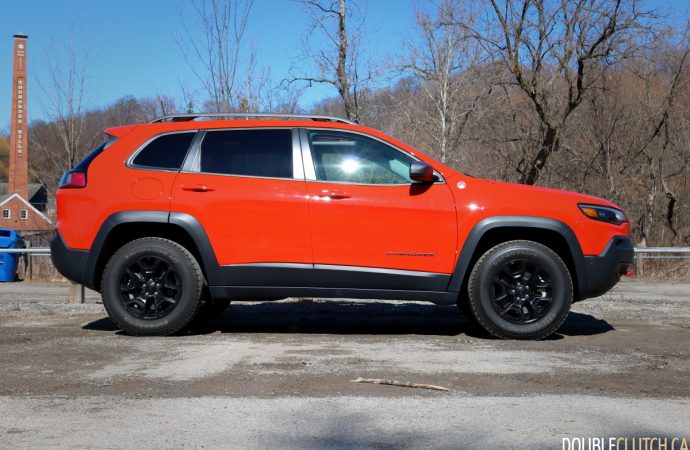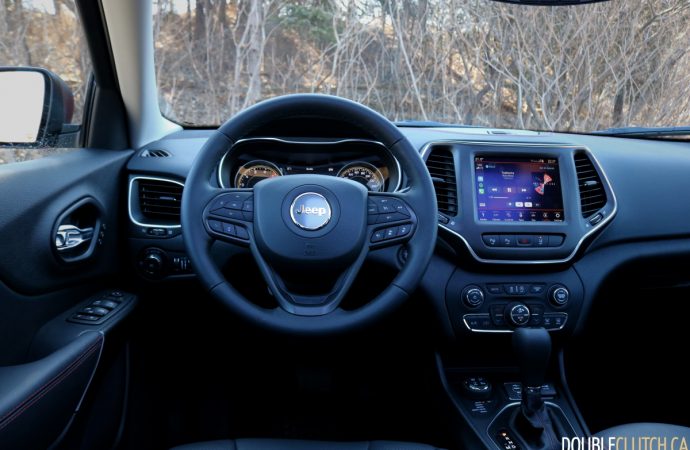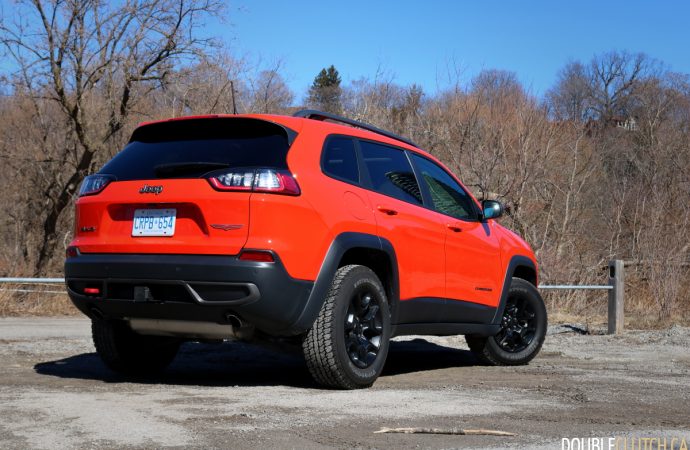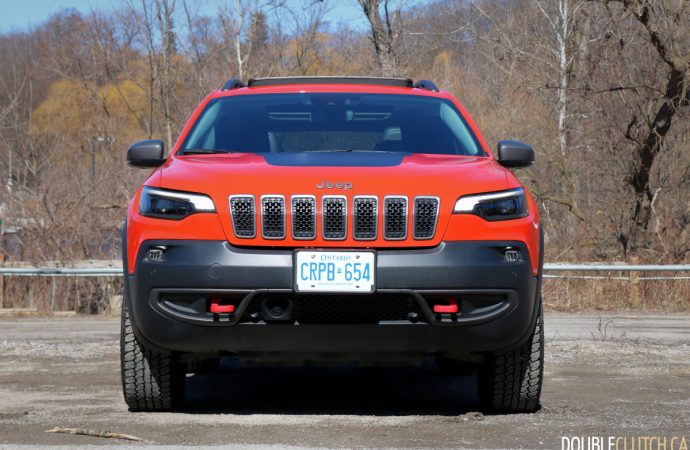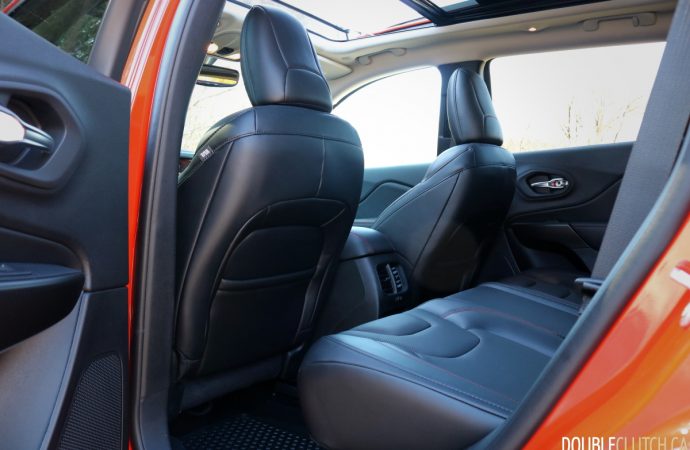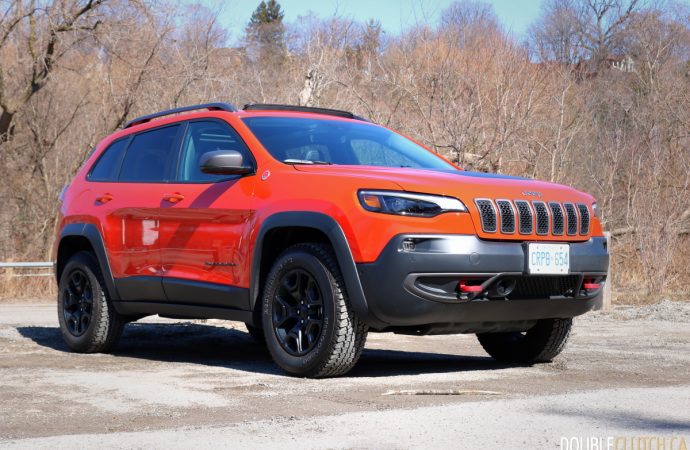For a while, the Jeep Cherokee stood unrivaled in being a compact crossover with genuine rough-and-tumble capability. Now though, new competitors are aiming to cash in on the trendy off-road lifestyle, which begs the question: can the Cherokee still hold its own? We tested a 2021 Jeep Cherokee Trailhawk Elite to find out.
On the outside, the Cherokee Trailhawk Elite’s distinctive style lies in the way that it’s toughened up without being as boxy as many of the latest crossovers. The butch wheel arches, bright tow hooks and chunky tires contrast nicely with the curved greenhouse, sleek nose and complex curvatures of the side panels. Speaking of that nose, it’s certainly a departure from the shark-like nose now more conventional. In a way, this regression to a more traditional form only serves to be more distinctive now that many manufacturers have embraced the split-level lighting look.
Up front, there’s plenty of room and a surprising amount of soft-touch plastic. Props to Jeep for putting a bin on top of the dashboard for snack bars, carabiners, oversized meme-worthy sunglasses and anything active lifestyle people like to have at their fingertips. Our test car came with ventilated seats, although it takes a minute to activate them as the controls for them are buried in the infotainment system.
On a positive note, the heated seats, heated steering wheel and ventilated seats have a level of memory to them. If the Cherokee was turned off with any of these functions on, they’ll fire back up the next time the car is started. It’s a little touch, but something all manufacturers should feature.
When it comes to the practicality expected from a compact crossover, the Cherokee boasts plenty of cargo and rear seat passenger space. The cargo floor is a bit high, but it’s lipless for easy loading and the power tailgate button is on the wall of the cargo area, a boon for shorter people, reanimated Tyrannosaurus Rexes or anyone who doesn’t particularly enjoy reaching all the way up to the tailgate.
Rear seat comfort is also excellent thanks to unexpectedly soft seats that recline to passengers’ preferred angle. While back there, passengers have a wide array of choice for charging their devices. Two USB-A ports, two USB-C ports and a household plug socket are conveniently located on the back of the centre console.
As for tech, Cherokee Trailhawk Elites get Stellantis’s UConnect 4C infotainment system. An 8.4-inch touchscreen with Apple CarPlay and Android Auto capability comes set into the dashboard as standard, as do onboard navigation and satellite radio. While a bit dated compared to newer offerings, the Cherokee’s infotainment is still reasonably responsive and user-friendly, and offers a whole bunch of cool features like Off Road Pages. Drivers can monitor the status of the four-wheel-drive system, vehicle pitch and roll, and a whole bunch of accessory gauges for keeping an eye on vehicle health when the going gets tough.
On tap in our test car as part of the $1,995 Sun and Sound package is an Alpine premium audio system that sports a warm sound signature and plenty of amplification. Harmonic distortion is within acceptable limits for a retail-grade premium audio system, although we wish the staging was a bit more advanced. Curiously, we couldn’t find any Alpine logos inside the Cherokee to denote the upgraded audio system.
Powering the Jeep Cherokee Trailhawk is a naturally-aspirated 3.2-litre V6 making 271 horsepower and 239 lb-ft of torque. A V6 is a rarity in the compact crossover segment, so the extra motivation over a standard four-cylinder is very welcome. However, much of the V6 power is difficult to access in everyday driving. Any midrange pull is only occasionally glimpsed in fleeting moments, like the mind sincerely believing it has rationalized dadaism.
To really get the most out of this V6, it has to be revved out to the torque peak of 4,400 RPM. Doing so elicits quite a lot of engine noise, although the top-end surge towards redline is very satisfying. What isn’t so satisfying is the ZF nine-speed automatic gearbox, which has a tendency to trip over its own feet. It’s an uncouth slamdance of lag, lurch and the occasional violent whunk that will make drivers used to smoother machines get out and check the ground for a trail of transmission fluid.
There is a way of getting around this though, and it’s simply by sliding the gear selector to the left and using the manumatic mode, something we don’t expect the average Cherokee buyer to do often. As a happy bonus, the lever directions for upshifts and downshifts are ergonomically correct. Pull towards the driver for upshifts and away from the driver for downshifts, just like in a race car.
As for the Cherokee’s ride and handling, it’s a bit of a mixed bag. The light, vague steering makes it easy to drive casually and the brakes are absolutely fantastic with great pedal feel and stopping power. Elsewhere though, it’s just not as refined as its newer competition. Our Trailhawk Elite tester rolls on Firestone all-terrain tires that look beefy but generate a lot of vibration and a low-pitched roar over the road.
As a result of these tires, the ride is quite busy at times with lots of little motions working their way through the suspension at highway speeds. However, ratchet down to city speeds and the Cherokee simply absorbs all sorts of unpleasantness from potholes to frost heaves to metal road plates.
While the V6 may pay dividends in power, it’s easy to assume that it, along with the knobby tires, would significantly impact fuel economy. In reality, the truth is a bit more nuanced than that. We averaged 11.8L/100km in mixed driving on winter blend fuel, not far off from the government’s rating of 11.5L/100km and similar to figures we’ve achieved from turbocharged four-cylinder competitors. Curiously, Jeep has decided that the Cherokee’s fuel tank should essentially be the reservoir from a Zippo. We saw less than 400 kilometres of driving before the low fuel light came on.
In conclusion, the 2021 Jeep Cherokee Trailhawk Elite is a competent compact crossover. Although we wish for more refinement, it does the spec’d-up rugged small crossover thing reasonably well. That would be good enough, except there’s one small issue at hand. As tested, our Cherokee was $47,285. A comparably-equipped Ford Bronco Sport is less expensive, has more room inside and is a efficient vehicle. That being said, while better options than the Cherokee may now exist, it’s still there for those who absolutely want their SUV to be a Jeep.

















